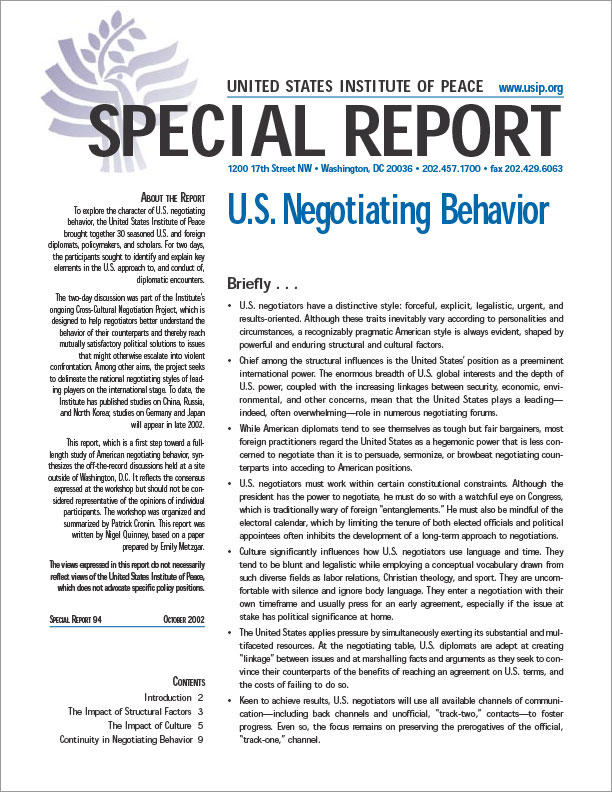U.S. Negotiating Behavior

Summary
- U.S. negotiators have a distinctive style: forceful, explicit, legalistic, urgent, and results-oriented. Although these traits inevitably vary according to personalities and circumstances, a recognizably pragmatic American style is always evident, shaped by powerful and enduring structural and cultural factors.
- Chief among the structural influences is the United States' position as a preeminent international power. The enormous breadth of U.S. global interests and the depth of U.S. power, coupled with the increasing linkages between security, economic, environmental, and other concerns, mean that the United States plays a leading--indeed, often overwhelming--role in numerous negotiating forums.
- While American diplomats tend to see themselves as tough but fair bargainers, most foreign practitioners regard the United States as a hegemonic power that is less concerned to negotiate than it is to persuade, sermonize, or browbeat negotiating counterparts into acceding to American positions.
- U.S. negotiators must work within certain constitutional constraints. Although the president has the power to negotiate, he must do so with a watchful eye on Congress, which is traditionally wary of foreign "entanglements." He must also be mindful of the electoral calendar, which by limiting the tenure of both elected officials and political appointees often inhibits the development of a long-term approach to negotiations.
- Culture significantly influences how U.S. negotiators use language and time. They tend to be blunt and legalistic while employing a conceptual vocabulary drawn from such diverse fields as labor relations, Christian theology, and sport. They are uncomfortable with silence and ignore body language. They enter a negotiation with their own timeframe and usually press for an early agreement, especially if the issue at stake has political significance at home.
- The United States applies pressure by simultaneously exerting its substantial and multifaceted resources. At the negotiating table, U.S. diplomats are adept at creating "linkage" between issues and at marshalling facts and arguments as they seek to convince their counterparts of the benefits of reaching an agreement on U.S. terms, and the costs of failing to do so.
- Keen to achieve results, U.S. negotiators will use all available channels of communication--including back channels and unofficial, "track-two," contacts--to foster progress. Even so, the focus remains on preserving the prerogatives of the official, "track-one," channel.
- The American media can play an important role in setting the agenda for negotiations but they rarely exercise much impact on the negotiations themselves and are seldom used by U.S. negotiators to help shape outcomes.
About the Report
To explore the character of U.S. negotiating behavior, the United States Institute of Peace brought together 30 seasoned U.S. and foreign diplomats, policymakers, and scholars. For two days, the participants sought to identify and explain key elements in the U.S. approach to, and conduct of, diplomatic encounters.
The two-day discussion was part of the Institute's ongoing Cross-Cultural Negotiation Project, which is designed to help negotiators better understand the behavior of their counterparts and thereby reach mutually satisfactory political solutions to issues that might otherwise escalate into violent confrontation. Among other aims, the project seeks to delineate the national negotiating styles of leading players on the international stage. To date, the Institute has published studies on China, Russia, and North Korea; studies on Germany and Japan will appear in late 2002.
This report, which is a first step toward a full-length study of American negotiating behavior, synthesizes the off-the-record discussions held at a site outside of Washington, D.C. It reflects the consensus expressed at the workshop but should not be considered representative of the opinions of individual participants. The workshop was organized and summarized by Patrick Cronin. This report was written by Nigel Quinney, based on a paper prepared by Emily Metzgar.
The views expressed in this report do not necessarily reflect views of the United States Institute of Peace, which does not advocate specific policy positions.



